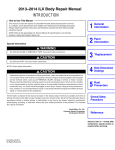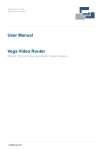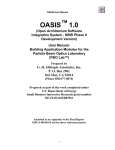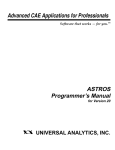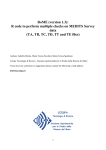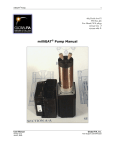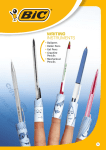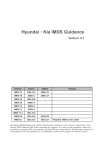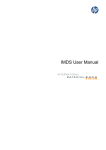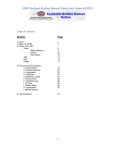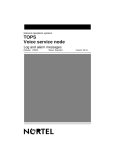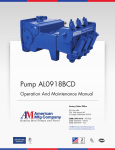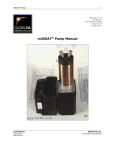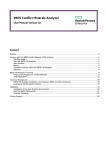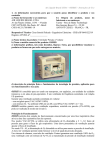Download TITRE DU DOCUMENT - IMDS Information Pages
Transcript
DOCUMENTATION NOTICE 80 - 00 - 044 / - - C IMDS DOCUMENTATION RULE FOR RENAULT SUPPLIERS Renault Automobiles Standardisation DQ-EDP / Department 67250 RENAULT 80 - 00 - 044 / - - C This document is to be considered as a whole, the parts of which must not be separated. © RENAULT 2014. No duplication permitted without the consent of the issuing department. No circulation permitted without the consent of RENAULT. FIRST ISSUE July 2008 --- This issue originates from draft NC 2008 0499 / - - -. REVISIONS November 2011 - - A This issue originates from draft NC 2011 0845 / - - - . January 2014 - - B This issue originates from draft NC 2014 005 / - - - . May 2014 - - C This issue originates from draft NC 2014 0312 / - - - . REFERENCED DOCUMENTS Standards : 00-10-415, 00-10-050. EC guidelines : 2000/53/CE, 2005/64/CE, 1907/2006, 2009/425 Other regulations : ISO 1043 / ISO18064/ ISO 1629. © RENAULT 2014 PAGE 2/33 RENAULT 80 - 00 - 044 / - - C Follow-up of the document ________________________________________________________ Version Author Summary of major changes 1.0 2.0 2.1 2.2 3.0 Document revision date 03/01/2006 23/07/2007 19/09/2008 15/09/2010 18/08/2011 Renault DIMat Renault DIMat Renault DIMat Renault DIMat Renault DIMat 4.0 02/01/2014 Renault DE-TC Creation of the document Update Update Update Field experience taken into account Anticipative lists taken into account Update to IMDS 8.0. Controls evolution with Matsub taken into account. Integration of the semi-components 5.0 Renault DEA-TC This version of the document is 5.0. Be sure that you have the latest version. The latest version is available on: - Renault’s supplier portal (https://suppliers.renault.com/ ou http://suppliers.renault.enxo.org) - IMDS portal (www.mdsystem.com), IMDS Information pages / Section “Help” / Section “FAQ”/ Category “OEM Specific Info” / Renault” This document refers to the English version of IMDS; the French version is also available. Objectives of the IMDS user guide _____________________ This is the Renault’s suppliers reference document for the declaration of materials and substances attached to every part supplied to Renault (cf. Renault general prescriptions 00-10-415), standard available on the Renault’s suppliers portal. The weights, the materials and the substances for all the constituents of the part have to be declared according to the standard 00-10-050 "Prohibited or restricted substances – Lists and declaration modes" through the IMDS system. Renault objectives in IMDS ___________________________ The environmental regulatory requirements quickly change and we need to have the knowledge of the material and substances of the parts (Directive “End of Life Vehicle” - 2000/53/EC, directive certification of homologation - 2005/64/EC, Reach regulation - 1907/2006/EC). To comply with these rules and their possible evolutions, Renault has to have information about materials and substances of all the materials composing parts of the vehicle. Therefore, Renault requests the list of all substances composing a material, including these that are or not regulated. © RENAULT 2014 PAGE 3/33 RENAULT 80 - 00 - 044 / - - C CONTENTS Page OBJECTIVES OF THE IMDS USER GUIDE 3 1. 6 2. 3 4 USE OF IMDS 1.1 REGISTER TO IMDS 6 1.2 IDMS INFORMATION PAGES 6 1.3 IMDS TRAINING 7 1.4 CONNECT TO IMDS 9 1.5 IMDS RECOMMENDATIONS 9 STRUCTURE OF AN MDS: ESSENTIAL REMINDERS 10 2.1 COMPONENT / SEMI-COMPONENT / MATERIAL / SUBSTANCE 10 2.2 TREE STRUCTURE 11 2.3 SEMI-COMPONENTS 11 2.4 MATERIALS 11 2.5 DECLARATION OF SUBSTANCES 12 MDS DOCUMENTATION 12 3.1 MENU FOR CREATING A MDS 12 3.2 COMPONENT DOCUMENTATION 13 3.3 SEIMI-COMPONENT DOCUMENTATION 14 3.4 MATERIAL DOCUMENTATION BY THE MATERIAL SUPPLIER 15 3.5 USAGE OF A MATERIAL IN A COMPONENT OR A SEMI-COMPONENT 18 3.6 “SUPPLIER’S DATA” DOCUMENTATION 19 RENAULT SPECIFICITIES 20 4.1 RENAULT’S SUBSTANCES STANDARD 00-10-050 INTEGRATED IN IMDS 20 4.2 SEMI-COMPONENT 20 4.3 “SAMPLE DEVELOPMENT REPORT” OPTION 21 4.4 “AUTHORISED TRANSFER” OPTION 21 4.5 PARTS EXISTING IN SEVERAL COLORS 21 4.6 PARTS WITH DIVERSITY ON ONE MATERIAL 22 4.7 WEIGHT 22 © RENAULT 2014 PAGE 4/33 RENAULT 5 6 80 - 00 - 044 / - - C 4.8 MDS EXAMPLE 23 4.9 IN WHICH CASE DO YOU HAVE TO SUBMIT AN MDS? 24 TRANSMISSION AND VALIDATION OF THE MDS 25 5.1 MDS TRANSMISSION 25 5.2 CHECK 27 5.3 MDS VALIDATION BY RENAULT 28 OVERVIEW OF THE RENAULT MDS MANAGEMENT PROCESS © RENAULT 2014 30 PAGE 5/33 RENAULT 1. 80 - 00 - 044 / - - C USE OF IMDS IMDS can be accessed through internet on: www.mdsystem.com 1.1 REGISTER TO IMDS When a user wishes to use IMDS for the first time, it is necessary for him to obtain a user name and a password at IMDS (these accesses are independent of Renault). If the company is already registered in IMDS: ask for the creation of a personal access to your company’s IMDS administrator. The access is strictly personal, and the Renault’s materials and substances declaration process requires a rigorous completion of your personal information (including e-mail address). - - If your company is not yet registered in IMDS: follow the registration procedure described in the document “IMDS User Manual”, paragraph 2.2. You can reach the registration page on “IMDS Information Pages” / section “IMDS login”/ “Register your company”: For all questions related to registration, user ID, password or connection problems, you can contact the French hotline at +33 1 57 32 48 56 or by e-mail ([email protected]). 1.2 IDMS INFORMATION PAGES IMDS Information Pages are available at the following Internet address: https://public.mdsystem.com/web/imds-public-pages The Information Pages enable IMDS users to be informed about the evolutions of the system and about rules interpretations. In particular, you can refer to Frequently Asked Questions (FAQ) of IMDS Information Pages in the "Help" menu. © RENAULT 2014 PAGE 6/33 RENAULT 1.3 80 - 00 - 044 / - - C IMDS TRAINING The so-called « IMDS user manual » document is available on IMDS public pages. It details the functionalities and the way to administrate IMDS system. This IMDS user manual (PDF format) is available on: - IMDS Public pages / Section “New to IMDS?” / category “Reading for new users” / right-hand side menu © RENAULT 2014 PAGE 7/33 RENAULT There are various trainings at IMDS to go deeper in details. For more information: IMDS Information Pages / Section “New https://public.mdsystem.com/web/imds-public-pages/imds-training-courses. © RENAULT 2014 80 - 00 - 044 / - - C to IMDS” or direct link PAGE 8/33 RENAULT 80 - 00 - 044 / - - C Moreover, independent consultants offer guidance services on the organisation to put in place in the company in order to document efficiently the materials and substances declarations. This helps improve efficiency and gain time. 1.4 CONNECT TO IMDS It is necessary to have a user name and a password (cf. paragraph registration) to use IMDS. IMDS homepage can be found at the following URL: http://www.mdsystem.com/ To reach IMDS screen connection, click on the icon of the homepage. A new Internet page opens and the connection screen opens: enter your user name and password, choose your language and click on the button "Login". ID Password Language In case of difficulty, a French hotline is made available by IMDS, from Monday to Friday from 8.00 to 16.30, on +33 1 57 32 48 56 or by e-mail ([email protected]). This hotline is meant for questions related to the connection to IMDS and to the usage of IMDS functionalities. For any other problem (in particular related to Renault specificities), write to the address [email protected]. 1.5 IMDS RECOMMENDATIONS The users of IMDS agreed on rules concerning the completion / definition / structure of the MDS. Please carefully read these rules in order to avoid MDS rejection for non-compliance reasons. IMDS recommendations are available once connected to the IMDS system. They are downloadable from the help menu, "Recommendation" of IMDS application. A document in French summarizing IMDS recommendations is available on Renault’s supplier portal and on IMDS portal (IMDS public pages / Section “FAQ” / category “OEM Specific Info” / “Renault”). This document does not replace the IMDS reference documents. © RENAULT 2014 PAGE 9/33 RENAULT 2. 80 - 00 - 044 / - - C STRUCTURE OF AN MDS: ESSENTIAL REMINDERS A MDS (Material Data Sheet) is a declaration of materials and substances. It appears in IMDS as a tree structure. The tree structure gives information about the structure (decomposition into elementary pieces) and the composition of every part or material delivered to Renault. 2.1 COMPONENT / SEMI-COMPONENT / MATERIAL / SUBSTANCE The component, depicted by , is used to describe the classification of a part, i.e. the breakdown of the part into elementary sub-components. When the component is at the top of the tree structure, it represents the part delivered to Renault as it is found in the vehicle. The semi-component, depicted by . Is used to describe a generic supply like a steel coil or a pipe supplied by rolls. This supply is afterwards reworked in the Renault plant: for example the pipe is cut to the proper length. A material, depicted by , is used to describe the chemical composition of a material. Each component of the lowest level comprises one or many homogenous materials, i.e., a material uniform in the space, which shows elements that are all identical (e.g. cover material, screw material, each layer of a surface treatment). The part has to be broken down to the homogenous or single material. A material has to be broken down into substances and 100% of the substances present in a material have to be declared. NOTE: It is possible to use “Joker” substances at the quantity of 10% of the total weight, at the most, in the material breakdown. However, be careful, these “Jokers” do not ensure material compliance in the long run. Sheets containing jokers must be frequently verified or updated. It is strongly advised to choose the system of confidential substances. Moreover, jokers are only authorised when the substances are not to be declared according to the Renault standard 00-10-050. If substances from standard 00-10-050 are present in the material, they must be declared through IMDS. The substances, depicted by , are material constituents. They are chemical elements, components at natural state or components originating from a manufacturing process (e.g. Iron, Carbon and Silicon for a steel; PP and Titanium dioxide for a polypropylene). An almost-exhaustive list of substances, defined by IMDS, is the basis for the declarations. The substances to be declared correspond to the substances which remain in the vehicle when it comes out of the assembly chain. For example, a paint supplier has to declare the composition of the dry paint; a sheet metal supplier, the composition of degreased sheet metal. © RENAULT 2014 PAGE 10/33 RENAULT 80 - 00 - 044 / - - C 2.2 TREE STRUCTURE Different types of “nodes” (component, semi-component, material, substance) should not appear at the same classification level. The main component can be broken down either into materials or into subcomponents then into materials but not both. Example: a metal with coating is not a homogenous material. The metal and the coating are two different materials. They can be directly linked to a component or a semi-finished component. 2.3 SEMI-COMPONENTS 2.3.1 Semi-components directly sent to Renault Renault asks its suppliers of semi-components to document their decomposition in material and substances into IMDS and to send them to Renault. 2.4 MATERIALS A material is characterised by its normalised description, its trade reference and its composition in substances. 2.4.1 Materials directly sent to Renault: Renault asks its suppliers of materials to document their decomposition in substances into IMDS and to send them to Renault. The published material data sheets of materials do not guarantee the compliance with Renault 00-10-050 standard. 2.4.2 Materials in components or semi-components sheets IMDS standard sheets describe certain materials; this is in particular the case for most metals. It is strongly advised to use standard sheets when they are available (refer annex II). Material sheets that can be considered as standard are published by: - IMDS Committee - ILI Metals - Stahl und Eisen. When there is no standard sheet available, you have to use a MDS sent by your material supplier. You have to verify that substances declared in the material are really the used ones. CAUTION: One can find many data of questionable quality published in IMDS, do not use them, else your sheet will be rejected. THE PUBLICATION IS NOT A QUALITY INDICATOR. © RENAULT 2014 PAGE 11/33 RENAULT 80 - 00 - 044 / - - C 2.5 DECLARATION OF SUBSTANCES Materials have to be broken down into substances, the breakdown should include the main material or the elements for an alloy but also possible additives of all types, the sum of the ratios of the declared substances have to be 100%. 2.5.1 Confidential substances and Jokers However, the substances for which the declaration is not mandatory (except SVHC, NGO, and GADSL) can be marked “confidential”. In this case, the supplier documents the substance in the material and ticks the box “confidential”. This substance is then replaced by **** for all other users, except the users assigned by the author of the sheet as “trusted users”. The latter are the only ones to see the information. It is not possible to download confidential data from the sheet, even for the end user. It is not possible to copy the sheet and to find the initial data. It is not possible to hide black substances information. 2.5.2 Addition of new substances HP handles the list of the basic IMDS substances; a user cannot add a substance by himself. If a substance does not exist in IMDS, the supplier can request its creation by HP by calling the IMDS hotline or through the menu “basic substance request”. HP has to validate the request. The list of basic substances is updated once a month. 3 MDS DOCUMENTATION 3.1 MENU FOR CREATING A MDS After identification, a MDS can be created by choosing “MSD”, then “New” and “Datasheet” (a “module” cannot be sent to Renault). You can create three types of MDS: “component”, “semi component”, or “material”. In this section, we detail how to fill in these three types of MDS. © RENAULT 2014 PAGE 12/33 RENAULT 80 - 00 - 044 / - - C 3.2 COMPONENT DOCUMENTATION All standard IMDS functionalities can be used (refer § 1.3 “IMDS Training” and §1.5 “IMDS Recommendations”). Note: before creating a « component » type MDS, make sure that all the materials that you will use already have an MDS: - MDS of standard material - MDS of your material supplier - MDS to be created from before-hand for the materials that you manufacture. In this case, you have to start with “making it internally available”. For this, first of all create your material MDS, enter the supplier’s information, then select “Release internal” in the section “recipient’s data”. Component without MDS attached Component with MDS attached 1 2 1 2 3 6 4 5 4 5 © RENAULT 2014 PAGE 13/33 RENAULT Field name 1 2 <Description> <Part/Item No.> 80 - 00 - 044 / - - C Field description Corresponds to the name of the Renault part Corresponds to the Renault part reference Declaration instructions Mandatory text in French Two cases: * If the component is at the top of the structure: mandatory field 10 characters Example = Air filter = 8200123456 * Otherwise: optional Field 3 <Development Sample Report> 4 <Measured Weight per item> 5 <Tolerance> 6 <Quantity> Partial documentation of materials and substances Ticking this case is prohibited Measured weight of the whole part Mandatory field Number Difference (in percentage) between measured weight and calculated weight Mandatory field Number < 10% ; controlled during MDS sending phase Mandatory field (to be completed only for the sub-component) Number > 0 Occurrence of the subcomponent within the part = 1500 g = 10% =3 3.3 SEMI-COMPONENT DOCUMENTATION All standard IMDS functionalities can be used (refer § 1.3 “IMDS Training” and §1.5 “IMDS Recommendations”). Note: before creating a « semi-component » type MDS, make sure that all the materials that you will use already have an MDS: - MDS of standard material - MDS of your material supplier - MDS to be created from before-hand for the materials that you manufacture. In this case, you have to start with “making it internally available”. For this, first of all create your material MDS, enter the supplier’s information, then select “Release internal” in the section “recipient’s data”. © RENAULT 2014 PAGE 14/33 RENAULT 80 - 00 - 044 / - - C Semi-component without MDS attached Semi-component with MDS attached 3 1 2 4 Type de donnée à documenter Field name Field description <Article Name> Correspond to the name of the semi-component <Item- /Mat.-No> Corresponds to the Renault part number Texte obligatoire en français Two cases: * If the semi-component is at the top of the structure: mandatory field 10 characters Example Engine flywheel 123118379R * Otherwise: optional Field <Development Sample Report> <Specific weight> Partial documentation materials and substances Weight by length, area volume of or Ticking this case is prohibited Mandatory field Number = 1500 g/m3 3.4 MATERIAL DOCUMENTATION BY THE MATERIAL SUPPLIER The kind of information to provide depends on the nature and the composition of the material. When creating a “material” type MDS, you have to classify it. There are nine different classes of material: 1 2 3 4 5 6 7 8 9 Steel and iron materials Light alloys, cast and wrought alloys Heavy metals, cast and wrought alloys Special metals Polymer materials Process polymers Other materials and material compounds (scope of mixture) Electronics / electrics Fuels and auxiliary means You have to choose the category of material and its sub-category: © RENAULT 2014 PAGE 15/33 RENAULT 80 - 00 - 044 / - - C For polymers the symbol has then to be defined. The declaration of symbols for polymers and elastomers (refer annex I) is very important for Renault. The symbol has to correspond to the ISO standards in effect and to be the same in IMDS and on the drawing. IMDS proposes a pull down menu, which helps refering to the ISO standards 1043, 18064 and 1629. It is allowed to exceptionally change the symbol manually by using the field “standardised and mixed description”. However all basic symbols of ISO standards are listed in the pull -down menu. Material symbols information are mandatory for the following material categories: - 5.1.a filled Thermoplastics - 5.1.b unfilled Thermoplastics - 5.2 Thermoplastic elastomers - 5.3 Elastomers / elastomeric compounds Then add the substances using the blue triangle . One hundred percent of the substances composing the material have to be declared, including their proportions. For polymers, all the additives and residuals of expected process substances or likely to be present in the finished product have to be declared: dye, flame retardant, release agent, trace of catalyst or monomer, etc. © RENAULT 2014 PAGE 16/33 RENAULT 80 - 00 - 044 / - - C The material has then to be documented as following: 1 2 3 4 5 6 7 8 9 10 © RENAULT 2014 PAGE 17/33 RENAULT Field name 1 2 <Name> <Trade name> 3 <Internal Mat-No.> 4 <Development Sample Report> 5 6 <No. Mat. Std> <Symbol> 7 <Classification> 8 <Norms / Standards> 9 <Supplier> 10 <Remark> 80 - 00 - 044 / - - C Description of the field Declaration instructions Example Material name Mandatory text = EPDM Corresponds to the commercial trade reference of the material Category 5: Mandatory text Otherwise: text wanted* = AH452V-5623 Material number Optional Text, not wanted = 1.2057 Partial documentation of materials and substances Standard material number (active for classifications 1, 2, 3 and 4) Standardized material name (active for classifications 5.1.b, 5.1.b, 5.2 and 5.3) Classification of the material according to the IMDS list Standard to which the material refers Name of the material supplier Ticking this case is prohibited Comments Optional Text, not wanted Optional Text, not wanted = EN-JN2039 According to the IMDS list, mandatory = PP-GF30 Mandatory text = Steels / cast steels / sintered steels Mandatory text Optional Text but wanted = Supplier of plastic X = Comments about the material EPDM * Except for the materials recommended by IMDS. See paragraphs 3.5 and 5.1 for more information about suppliers and recipient data. 3.5 USAGE OF A MATERIAL IN A COMPONENT OR A SEMI-COMPONENT The material MDS have to be identified from beforehand. When the user attaches the material to the component, he has to enter additional information. This information is relative to the usage of the material in the component. None, one or two fields can appear when the material is attached to the component: the field “Recyclate” and /or the field “Application” : The “Recyclate" field appears when the material belongs to IMDS categories 1, 2, 3, 4 or 5. If the material contains recycled material, then at least one of the two fields, either “Contents of post industrial recycled” or “Contents of post consumer recycled” have to be filled. The “Application” field appears when a substance used in the material is subject to a regulation. It allows you to precise the declaration of substances which benefit from exemptions, when they are present in concentrations below certain thresholds. For this purpose, refer to the 2000/53/CE guideline in effect: http://europa.eu/legislation_summaries/internal_market/single_market_for_goods/motor_vehicles/interacti ons_industry_policies/l21225_fr.htm. The application code “Other application (potentially prohibited)” can be ticked when other proposed applications are irrelevant. Be careful: in this case the substances are not allowed, and the MDS will probably be rejected. The application code “Concentration within GADSL limits” corresponds to the note of the last version of the Annex II of the Directive 2000-53-CE. It is advised to tick this case when the material contains less than 0,1% of lead, hexavalent chromium or mercury and less than 0,01% of cadmium. © RENAULT 2014 PAGE 18/33 RENAULT 80 - 00 - 044 / - - C 1 2 3 4 Field name 1 2 3 4 <Weight> Field description Material weight in the component <Content of post industrial/preconsumer recyclate> Percentage of preconsumer recycled material <Content of post consumer recyclate> Percentage of post consumer recycled material <Application> Application benefiting from an exemption regarding the substance in the material Declaration instructions Mandatory number Mandatory number, if there is some recycled material in the component Mandatory number, if there is some recycled material in the component According to choice proposed by IMDS Example = 4,9 g = from 10 to 20 % = from 0 to 5% = Alloying element in steel for machining purposes or galvanized steel 3.6 “SUPPLIER’S DATA” DOCUMENTATION Information about your company or other suppliers has to be filled in the page entitled “supplier data”. You have to indicate the contact details of the person to contact in case of any questions regarding MDS; this person is not necessarily the author. © RENAULT 2014 PAGE 19/33 RENAULT 80 - 00 - 044 / - - C 4 RENAULT SPECIFICITIES 4.1 RENAULT’S SUBSTANCES STANDARD 00-10-050 INTEGRATED IN IMDS Every Renault supplier has to fill in information, complying with 00-10-050 standard at the index contracted in the RFQ. This standard classifies hazardous substance in three categories: N (black), G (grey) and O (orange). 00-10-050 standard substances list is available on Renault suppliers’ portal and an excel file listing the different substances can be downloaded in the Renault’s specific screen. This standard appears in IMDS so that suppliers can see if the MDS they propose to Renault contains Black, Grey or Orange substances. In IMDS, the Renault’s substances standard integration is visible when using the filters available in the MDS “Ingredients” chapter. Four filters are available: - Black substances - Grey substances - Orange substances - Global list (which shows the Black, Grey and Orange substances) When a filter is applied, the corresponding hazardous substances appear in red colour. In this example, the “Renault Black” substances filter is selected: lead appears in red, as it is a black substance according to Renault 00-10-050 standard. 4.2 SEMI-COMPONENT IMDS proposes the semi-component’s structure, depicted by . This structure allows describing semi-finished products as metal sheet with coating or many-layered fabrics, which are neither homogeneous material nor compounds. © RENAULT 2014 PAGE 20/33 RENAULT 80 - 00 - 044 / - - C Semi-components type MDS have previously been not accepted by Renault but now Renault wishes to receive semi-component type MDS for the cases mentioned above. 4.3 “SAMPLE DEVELOPMENT REPORT” OPTION When creating a MDS, it is possible to tick the box “Sample Development report” in chapter 1 “Ingredients”. This enables you to create a MDS without giving the entire substances information. However Renault wishes to receive MDS containing 100% of substances information. Consequently, do not tick the box “Sample Development report”, else you will not be able to send your MDS to Renault. Renault refuses all MDS where this box is ticked. It is important that you transmit this information to your suppliers. 4.4 “AUTHORISED TRANSFER” OPTION The option “authorised transfer” must remain as “Yes”. 4.5 PARTS EXISTING IN SEVERAL COLORS In an effort to avoid multiple declarations, for parts existing in several colours Renault only asks for one declaration. This declaration should contain the MDS of the neutral part and different colours (each colour’s weight being divided by the number of colours). Example : A part (here “Component 3”) exists in 3 colours (here “blue”, “red” and “green”). The material weights 1000 g, and there are 90 g of colours per part. In the correct MDS, all 3 colours are included: Right MDS Wrong MDS Here, each colour weights 90/3 = 30 g of the total colour: © RENAULT 2014 PAGE 21/33 RENAULT 80 - 00 - 044 / - - C This type of documentation is asked for: - coloured materials - parts that can be coloured or not-coloured where the weight difference between the coloured part and the non-coloured part is less than 5%. 4.6 PARTS WITH DIVERSITY ON ONE MATERIAL In order to avoid multiple sending, Renault requires a single declaration when a part shows diversity on a single material: the declared weight of each material provided by different suppliers must be divided by the number of suppliers. 4.7 WEIGHT If the weight difference between the weight declared by the supplier in IMDS and the weight of the part known by Renault is too high, the MDS will be refused. The maximum authorised difference is 5%. © RENAULT 2014 PAGE 22/33 RENAULT 80 - 00 - 044 / - - C 4.8 MDS EXAMPLE The component ( ), which is at the top of the MDS tree structure must mandatorily represent the part supplied to Renault (having a Renault internal reference; for example 8200123456). The air filter (‘filtre à air’) is a part possessing a Renault reference (ex: reference N ° 7756889441). Hence, it is a component ( ). The air filter top (‘couvercle’) is a subset of the air filter, hence it is a component ( ). No material is directly connected to it because this component is only made of components. The screw (‘vis fixation’) is a subset of the air filter. Hence, it is a component ( ). It is made of 4 homogeneous materials ( ): Screw body Steel : « C45 Pb » Anti-corrosion treatment Electrodeposited Zinc : « e-plate ZnNi(12-15) (electrodeposited Zinc) » Passivation : « Chromate film black ZnNi » Top Coat : « Sealant / Coating » The part’s designations must be in English. It is allowed to have fields in the following languages: - French - French with the translation in another language - English with the translation in another language. © RENAULT 2014 PAGE 23/33 RENAULT 80 - 00 - 044 / - - C 4.9 IN WHICH CASE DO YOU HAVE TO SUBMIT AN MDS? 4.9.1 General case Generally speaking every part or material supplied to Renault must be accompanied with an MDS. However, in some cases (e.g. software, etc.), MDSs are not required. The following table summarizes all use cases: Part type Part (general case) Neutral part Equipped 1 RMU (screw, fastening part, etc.) Raw parts Raw material Seat Cables Painted assembled body in white Assembly 2 Neutral assembly Color part Profile Software Imprint Supply No. Virtual Reference Services MDS required X X X MDS not required X X X Talk to designer Talk to designer Talk to designer X X X X X X X X X 4.9.2 Guided parts For the parts guided by Renault (e.g. fastening parts) in equipped parts, the supplier of the equipped parts receives one -or several- MDS from the suppliers of the sub-parts. Renault designer provides the equipped part supplier with the following information: Renault part reference, MDS ID number and name of the fastener’s contact person. The supplier of the equipped part can then contact the supplier of fastening part through the specified person. After reception of the MDS, he integrates it –or theminto the declaration of the equipped parts. 1.Sends fastening part MDS « RMU » fastening Supplier 3. Asks fastening’s MDS 4. Sends fastening’s MDS Renault Designer 2. Sends Fastening MDS Reference, ID & Contact person 5. Sends Equipped part MDS Supplier of the equipped part 4.9.3 Identical MDS for multiple references For the identical parts (e.g. right door and left door), there are many parts’ references but only one MDS is sufficient. You can use the function “Pieces for which the MDS is valid”, in Renault manufacturer screen (see 5.1.1). 1 2 Equipped: Physical grouping of parts which do not all have a Renault reference Assembly: Physical grouping of parts that all have a Renault reference © RENAULT 2014 PAGE 24/33 RENAULT 80 - 00 - 044 / - - C 4.9.4 Management of parts’ modifications If the part modification does not induce materials and substances modifications (composition or weight), it is not necessary to submit a new MDS. 5 TRANSMISSION AND VALIDATION OF THE MDS 5.1 MDS TRANSMISSION 5.1.1 Renault car manufacturer screen Renault’s identification number in IMDS is 10753. In order to manage IMDS data, Renault needs additional data. Consequently, an additional screen pops up when you propose an MDS to Renault. You can access Renault specific screen through "Recipient data" menu, after having clicked on the "Add" button and chosen "Renault" as car manufacturer, IMDS company ID 10753: In order to fill in this screen, you shall ask the designer the part’s reference and index, and the e-mail address of the person who has to validate the MDS. Please carefully check the index with the designer when you propose the MDS. The data contained in this screen are very important, as the MDS will be reviewed and validated by the Renault designer you are in contact with. © RENAULT 2014 PAGE 25/33 RENAULT 80 - 00 - 044 / - - C The car manufacturer screen for Renault visible hereunder. 4 1 5 2 6 3 7 Mandatory fields Fields not used by Renault Optional fields Field name 1 <Part/Item No.> 2 <Supplier Code> 3 <Forwarding allowed> 4 <Index Renault part> 5 <E-mail address of the designer> 6 <Index of the standard> 7 <Comment> © RENAULT 2014 Field description Corresponds to the Renault’s reference of the part Account number (provided by Renault) Agreement for the forwarding of the MDS Renault part index Declaration instructions Mandatory 10 characters Mandatory 6 digits number Example = 8200123456 ; APV7701450 Tick = ticked Mandatory 3 characters: ‘-‘ and alphanumeric characters (‘A’ ‘Z’) = --D = 123456 = firstname.lastname @Renault.com E-mail address of Renault designer in charge of the MDS of the part Mandatory text Index of Renault 00-10-050 standard contracted in the RFQ Mandatory 3 characters =--G Comments Optional Text = Comments about the part. PAGE 26/33 RENAULT 80 - 00 - 044 / - - C For more information and examples about the fields of Renault screen, simply click on the button open a help sheet for the documentation of the corresponding field: to 5.1.2 MDS Transmission IMDS gives four sending possibilities: - Send: pass on the MDS to the recipient (Renault for example). - Propose: pass on the MDS to several recipients (you have to add several companies). - Internal: publish the MDS for your company. You can use this function if you create a material MDS to be included into a component. - Publish: give the MDS to all IMDS users (Renault will not consider your MDS in this case). 5.2 CHECK At the time of MDS transmission, a list of errors and warnings appear. You have to correct each line of error to be able to transmit the MDS. © RENAULT 2014 PAGE 27/33 RENAULT 80 - 00 - 044 / - - C If you have already selected Renault as the recipient of the sheet, the check will be done taking into account Renault’s specific rules. GUIDELINE You can suggest to your suppliers to execute the following sequence: Select Renault (ID 10753) as recipient / Use the IMDS check tool / Correct the detected problems / Remove Renault from recipients list. In this way Renault’s specific rules will be taken into account during the sheet automatic check. 5.3 MDS VALIDATION BY RENAULT When a MDS is validated or rejected, the IMDS user is alerted in his IMDS personal profile. He needs to log on to IMDS and read the new messages. In case of the sending of a big series of sheets, it is strongly advised to carry out a trial on one sheet, and wait for its validation. Do not send the other MDS until all the remarks are resolved. 5.3.1 Administrative data Make sure to check description, part number, exact index, supplier code and recipient’s e-mail before sending your MDS; in case of error the sheet will automatically be rejected. The norms associated to the materials have to be documented. 5.3.2 Undesirable substances In case of unjustified presence of undesirable substances (black substances of the 00-010-050 standard or REACH regulation anticipative substances), the MDS will be rejected. In the case jokers and/or confidential substances are above 10% of the material content, the MDS will be rejected. If necessary, make sure to fill in the “Application” details. 5.3.3 MDS tree The same type of information must be present at a same MDS level. © RENAULT 2014 PAGE 28/33 RENAULT 80 - 00 - 044 / - - C 5.3.4 Modifying an MDS: A MDS with a whole number version can no longer be modified; you need to use the function “copy” / “new version” in order to change it to the following index. A MDS with a decimal number version can be modified. Can be modified Cannot be modified © RENAULT 2014 PAGE 29/33 RENAULT 80 - 00 - 044 / - - C 6 OVERVIEW OF THE RENAULT MDS MANAGEMENT PROCESS Who does? Task Illustration Designer or 1. material technical father Renault supplier Gives the supplier the references for which an MDS is required Creates an MDS corresponding to the part or semi-component or material supplied to Renault Selects the car manufacturer Renault Renault supplier Renault supplier Renault supplier Designer or material technical father Reference / index (part or material number) Fills in Renault specific screen Sends the MDS to Renault via IMDS Receives the file and accepts/rejects the MDS © RENAULT 2014 PAGE 30/33 RENAULT 80 - 00 - 044 / - - C ANNEX I Polymers’ description 5.1.a filled Thermoplastics 5.1.b unfilled Thermoplastics ABS-GF X PTFE-GF X PET-GF X POM-GF X PP-GF X PA6-GF X PA11-GF X PA12-GF X PA66-GF X PA66/6-GF X PBT-GF X PA6-MD X ABS ABS+PC ABS+PMMA AES MABS MBS SAN ABA ABAK SMS MMABS ASA PES PPSU PSU PFEP ETFE FEP PFA PTFE PVDF PCTFE PAEK PEEK PEOX PI PIB PPA PPS PVB PVFM PVP SMA S/MA SMAH AEPDMS PA11-MD X PA12-MD X PA66-MD X PA66/6-MD X P/E+EPDM-MD X PP-MD X PTFE-MD X POM-MD X CA CAB CAP CMC CN CTA MC CEF CP EC PVC PVDC ACPES ACS VCEMA VCEMAK VCEVAC VCMA VCMAK VCMMA VCOA VCOAK VCVAC VCVDC PEK PEKEKK PK P/E P/E+EPDM PA PA+PPE PA11 PA12 PA6 PA66 PA66/6 PBT PBT+PET PC PESU EEA EEAK EVOH LCP PAA PAI PBAK PEI AEPDS AMMA CSF EAA EBA EA EBAK EMA PAK PAN PAR PBN PCCE PCL PEUR PIR PVAC PVOH PVAL PVK SI COC PDCPD PMP © RENAULT 2014 PARA PEEST PEN PTT PE PE-HD PE-LD PE-LLD E/P PE-C PE-LMD PE-MD PEUHMW HDPE LDPE LLDPE UHMWPE MDPE CPE EPM PET PCT PMMA PMMI PMI POM PP PP+EPDM PP-E PP-HI PP/E PP+SEBS HIPP PPE PS PAGE 31/33 RENAULT 80 - 00 - 044 / - - C 5.2 Thermoplastic elastomers TEEE TPC TPU PEBA TPA SBS SEBS SEPS TPS TPO TPV TPZ BIIR CIIR CM CO CR CSM ECO GECO XCR FEPM FFKM EU FKM © RENAULT 2014 5.4 Duromers 5.4.1 Polyurethane PUREST PUR-GF X PUR-E 5.4.2 Unsaturated polyester UP-GF X 5.3 Elastomers / elastomeric compounds EVM FVMQ GPO FZ HNBR NR IIR EPDM IR ACM NBR AEM SB ANM SBR AU ABR BR IM NBM AFMU NIR FMQ PBR MSBR EPM 5.4.3 Other duromers CF MF MP MPF MUF P-SI PF UF VE PF-GF X PSBR PZ SIBR XBR XNBR XSBR MQ PMQ VMQ PVMQ PAGE 32/33 RENAULT 80 - 00 - 044 / - - C ANNEX II MDS of standard materials The MDS to be used are the MDS published by the following suppliers: - IMDS Committee, IMDS ID : 423 - IMDS Committee / ILI Metals, IMDS ID : 18986 - Stahl und Eisen List, IMDS ID : 313 - ZVEI-Rec019, IMDS ID 102677 © RENAULT 2014 PAGE 33/33

































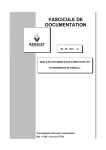
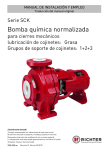
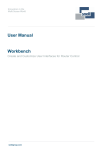
![3830 - SO02471 [96202 SW15623_0H Dwg13068A] Donovan](http://vs1.manualzilla.com/store/data/005999028_1-10b082f35c5d7c0c53e968105ce08056-150x150.png)
